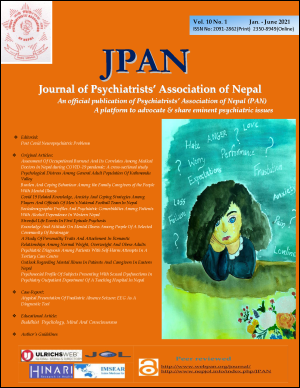Assessment Of Occupational Burnout And Its Correlates Among Medical Doctors in Nepal during COVID-19 pandemic: A cross-sectional study
DOI:
https://doi.org/10.3126/jpan.v10i1.40339Keywords:
COVID-19 pandemic, Lock-down, Burnout, Perceived Stress, Medical doctors, NepalAbstract
Introduction: The current COVID-19 pandemic has increased emotional and physical toll on healthcare workers. The burnout among doctors could be another psychological outcome due to this. Considering the dearth of literature we planned this study with an aim to explore burnout and its correlates among medical doctors of Nepal.
Material And Method: An online survey using a cross-sectional design and purposive sampling was conducted during the lock-down due to COVID-19 pandemic in Nepal. The tools used were basic proforma, Copenhagen Burn out Inventory (CBI) and Perceived Stress Scale (PSS). Descriptive and inferential statistical analysis (bivariate analysis followed by multiple linear regression) was performed with an objective to study prevalence of burnout and its correlates among the medical doctors.
Results: The average age of participants was 30.44 years with the majority being male. All the study participants reported moderate to severe level of perceived stress. Around half of them reported moderate to high burnout. The multiple linear regression analyses showed that perceived stress, and working in surgical department were significant correlates for personal and work-related burnout among medical doctors. Additionally, being front-line worker was a significant correlate for client-related burnout.
Conclusion: The burden and severity of burnout and perceived stress reported by the medical doctors during COVID-19 pandemic in the present study, suggests it to be an important mental health issue in Nepal. Suitable interventions for targeting this urgent issue of effectively reducing the burnout are warranted.
Downloads
Downloads
Published
How to Cite
Issue
Section
License
Copyright (c) 2021 Journal of Psychiatrists' Association of Nepal

This work is licensed under a Creative Commons Attribution 4.0 International License.
This license enables reusers to distribute, remix, adapt, and build upon the material in any medium or format, so long as attribution is given to the creator. The license allows for commercial use.




